Cost of Indian and Uzbekistani cotton yarn low amid surge in imports
I. In March 2024, there was a significant increase in cotton yarn imports
According to the latest customs data, China's cotton yarn imports in March 2024 surged back to a high of 169,700 tons, a year-on-year increase of 36.82% compared to March last year, and close to the peak import level in August-September 2023, far exceeding market expectations. It is reported that the surge in cotton yarn imports in March was mainly driven by pre-holiday replenishment, with the sudden increase in import volume to some extent due to delayed customs clearance and delivery processes during the Chinese New Year, and also demonstrated the domestic market's strong buying power for low-priced imported yarn before the holiday.

In March 2024, the average cost of cotton yarn imports in China was around $2.41/kg, marking a relatively low position in the past year. The decrease in the average import price of cotton yarn has attracted capital inflows for cotton yarn operations. Moreover, the focus of imports is gradually shifting from high-priced combed yarn to regular coarse carded yarn, leading to a significant improvement in profits for batches of imported cotton yarn in the sales of March and April.
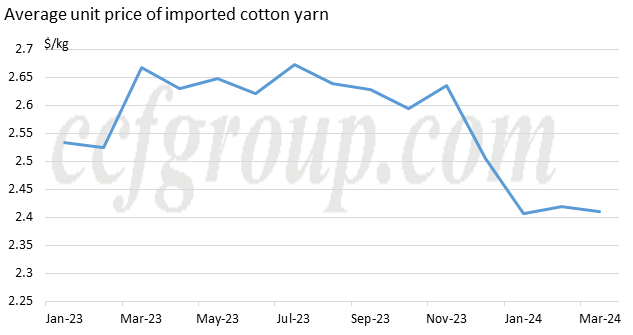
II. China's cotton yarn imports by origin in Mar 2024
In March 2024, the distribution of cotton yarn imports in China showed a more dispersed trend compared to previous periods. Vietnamese yarn imports totaled 59,700 tons, with its import share dropping to a new low of about 35%. India, Uzbekistan, and Pakistan each held a significant share. Uzbekistani yarn imports in March reached a record high since 2023 at 29,700 tons (17%), while Pakistani imports of 27,500 tons (16%) slipped to third place. Indian yarn imports in March also surged to 24,900 tons, far exceeding the total imports for January and February. In addition, Indonesia and Bangladesh also saw significant increases in yarn imports month-on-month. Overall, the market shows a substantial demand elasticity for Indian and Uzbekistani yarn, often attracting substantial domestic replenishment during price declines.
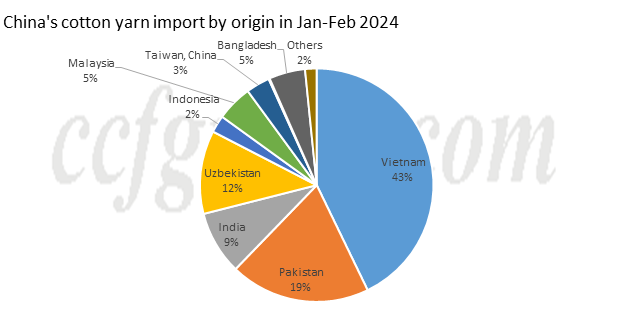
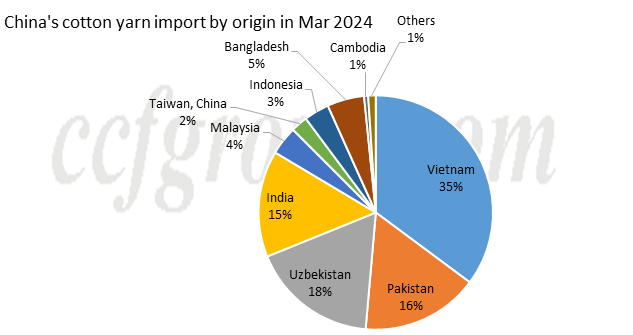
III. China's cotton yarn imports by structure in Mar 2024
In March, due to the continuity of cotton yarn arrivals, the structure of cotton yarn imports did not change significantly compared to January and February. The proportion of carded yarn slightly decreased compared to the previous months, with the import share of carded single yarn 25s dropping to 49.91%, totaling approximately 84,700 tons, becoming a major specification facing recent stock outs. The import share of carded single yarn of 25-30s increased to 3.57%, totaling around 6,057 tons, showing a significant increase. At the same time, the import share of combed single yarn of 8-25s in March increased to 6.70%, reaching a new high in monthly import volume of around 11,400 tons in recent years.
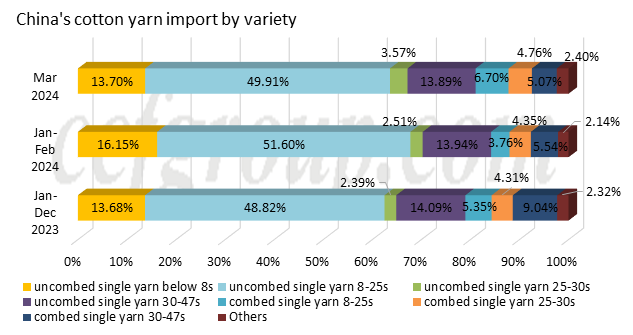
|
Main Import Specifications |
Vietnam |
India |
Uzbekistan |
Pakistan |
|
uncombed single yarn below 8s |
18.20% |
1.50% |
0.00% |
36.60% |
|
uncombed single yarn 8-25s |
50.00% |
40.00% |
28.00% |
63.30% |
|
uncombed single yarn 25-30s |
2.20% |
0.50% |
12.00% |
0.00% |
|
uncombed single yarn 30-47s |
7.40% |
0.80% |
58.00% |
0.00% |
|
combed single yarn 8-25s |
6.00% |
27.30% |
0.60% |
0.00% |
|
combed single yarn 25-30s |
5.20% |
14.10% |
0.20% |
0.00% |
|
combed single yarn 30-47s |
7.50% |
11.50% |
0.60% |
0.00% |
|
uncombed single plied yarn 8-25s |
0.50% |
3.90% |
0.00% |
0.10% |
IV. China's blended cotton yarn imports in Mar 2024
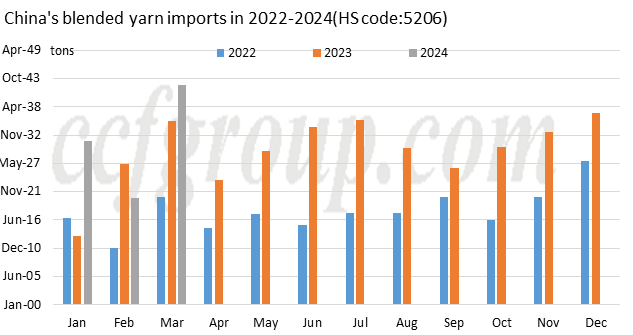
In March 2024, China's import situation of blended cotton yarn saw a significant increase, with a total of approximately 15,600 tons of which around 82% still originated from Vietnam. The demand for imported blended yarn has been gradually rising due to the traceability requirements in the textile industry. With the trend of Vietnamese yarn mills shifting towards producing blended yarn, domestic cotton yarn traders have been increasing their replenishment of blended yarn to avoid the intense competition in cotton yarn imports. Import statistics show that Zhejiang Province accounts for 30.33% of the imports, Guangdong Province holds a share of 26.45%, and Fujian Province has a share of 17.95%, making them the top three regions in terms of import volume. Overall, the sales prices of imported blended yarn have remained relatively stable in March and April, with seasonal overseas orders providing some support to the demand for imported blended yarn. Consequently, whenever profits expand, the import volume naturally increases.
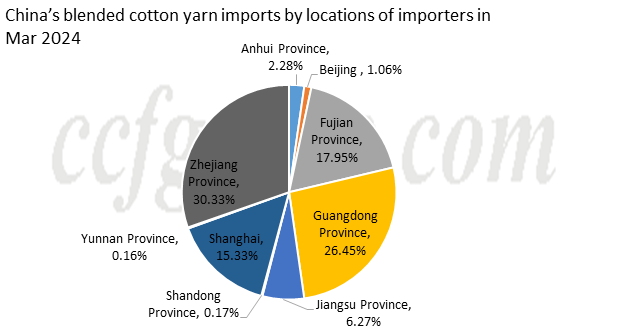
- Top keywords
- Cotton Price
- Cotton Futures Price
- Cotton Futures
- CZCE
- PTA Futures Price
- Chemical Fiber
- Polyester Prices
- Wool price
- PTA Futures
- Shengze Silk
- China
- Yarn Price
- price
- China Textile City
- Fibre Price
- Benzene Price
- Cotton
- Index
- Cotton Index
- PTA
- fabric price
- NYMEX
- Top 10
- textile industry
- Spot Cotton
- Cotton Yarn
- Polyester Price
- Futures
- PTA Price
- cotton yarn price

